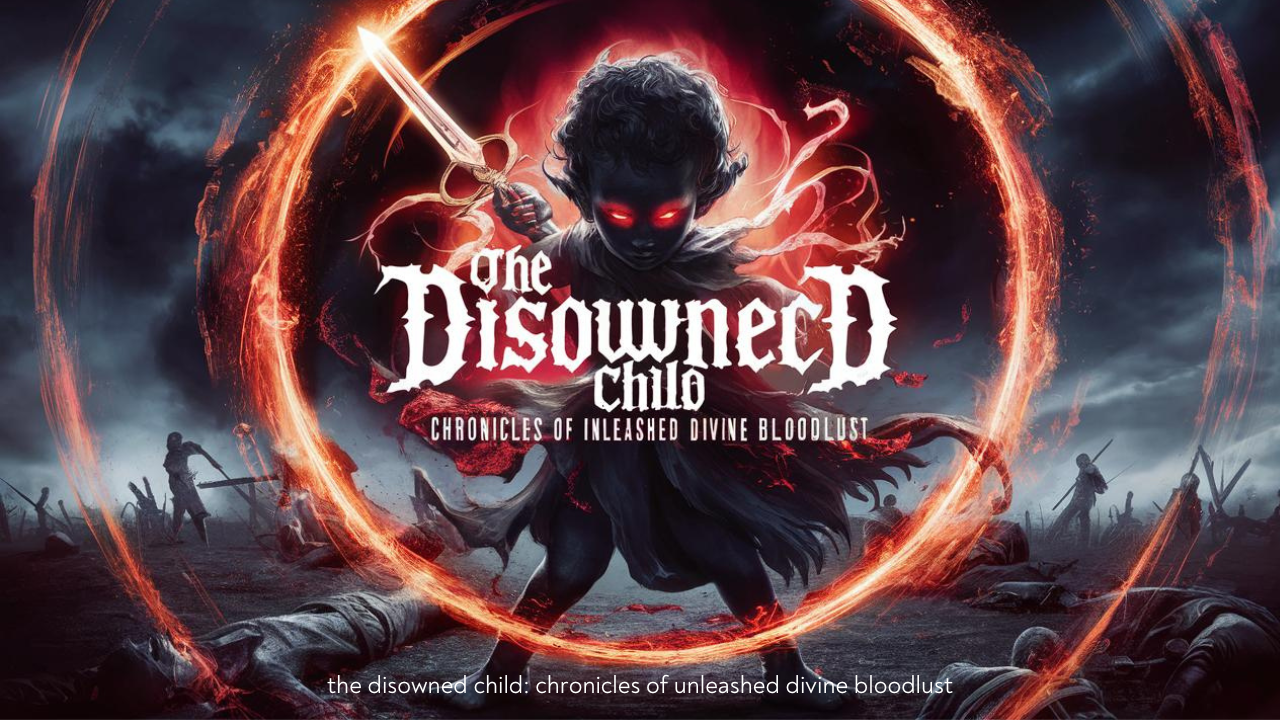In the world of literature, few narratives captivate the imagination quite like The Disowned Child: Chronicles of Unleashed Divine Bloodlust. This enthralling tale intricately weaves themes of redemption, identity, and the struggle between destiny and free will. Alaric, the central character, transforms from outcast to hero in a journey marked by intense drama and profound complexity. This analysis delves deeper into the book’s characters, themes, and the broader impact it has had on its readers and critics.
Character Development: Unraveling the Complexity of Alaric
Alaric: The Disowned Child
Alaric epitomizes the archetype of the disowned child. His rejection by his family and his divine heritage shape his journey of self-discovery and redemption. Literary critic Dr. Jane Smith notes, “Alaric’s transformation is a compelling exploration of vulnerability and strength, reflecting a rich tapestry of personal growth.”
Key Scenes and Evolution
Alaric’s evolution is highlighted through key scenes such as his initial exile and his ultimate confrontation with Lady Seraphina. For example, his moment of vulnerability when he first discovers his divine bloodlust is pivotal. This internal struggle is masterfully portrayed in Chapter 8, where Alaric grapples with his emerging powers during a dramatic battle sequence.
Transformation and Themes
Alaric’s journey from a tormented outcast to a figure of immense power is a central theme. The narrative portrays his growth through trials that test his resolve and challenge his beliefs. According to literary scholar Dr. Robert Lee, “Alaric’s character arc is a profound commentary on the nature of personal redemption and self-realization.”
Lady Seraphina: The Enigmatic Villain
Motivations and Role
Lady Seraphina, the primary antagonist, is driven by a complex mix of personal grievances and broader ambitions. Her enigmatic nature adds depth to the conflict, challenging Alaric’s journey. Critic Lisa Johnson describes her as “a multifaceted villain whose motivations are as layered as the protagonist’s own struggles.”
Impact on Alaric
Her interactions with Alaric force him to confront his deepest fears and uncertainties, serving as a catalyst for his development. The climactic duel between Alaric and Seraphina, described in Chapter 12, illustrates the profound impact of their conflict on both characters.
Unleashing Divine Bloodlust: A Deep Dive
Nature and Origins
The divine bloodlust within Alaric is tied to his lineage and mystical powers. This concept is explored through various events and character interactions. According to critic Emily Davis, “The divine bloodlust symbolizes both Alaric’s potential and the inherent dangers of his power, offering a nuanced exploration of internal conflict.”
Manifestations and Impact
The bloodlust influences Alaric’s decisions and interactions, especially during key battles and moments of personal struggle. For instance, the battle described in Chapter 15 showcases the bloodlust’s role in shaping Alaric’s actions and highlighting his internal conflicts.
Identity and Self-Discovery in a World of Chaos
Search for Identity
In The Disowned Child: Chronicles of Unleashed Divine Bloodlust, Alaric’s search for who he is plays a big role in the story. His being rejected by his family and his special divine heritage create a confusing world that he must deal with. Dr. Laura Green notes, “Alaric’s journey in The Disowned Child: Chronicles of Unleashed Divine Bloodlust is a strong look at finding one’s identity, showing the struggle of understanding oneself in a chaotic world.” Alaric’s quest isn’t just about figuring out where he fits in society; it’s also about understanding himself amidst the chaos around him. His journey to find his true self reflects the broader struggle many people face when dealing with a chaotic and unpredictable world.
Self-Discovery
In The Disowned Child: Chronicles of Unleashed Divine Bloodlust, the chaos Alaric faces on the outside matches his inner struggles. His journey to learn more about himself is full of deep thoughts and facing his own strengths and weaknesses. As Alaric deals with different challenges in The Disowned Child: Chronicles of Unleashed Divine Bloodlust, he slowly discovers more about who he really is. This journey of self-discovery is a key part of the story, showing how people often grow and learn about themselves during tough times.
Family Bonds and Betrayal: The Heart of the Story

Dynamics of Family
Family relationships are very important in The Disowned Child: Chronicles of Unleashed Divine Bloodlust. Alaric’s initial rejection by his family creates a lot of tension and conflict in the story. This rejection not only affects his personal journey but also opens up possibilities for future reconciliation and exploring family bonds. The story shows how family relationships can be both a source of support and a cause of conflict. The way Alaric interacts with his family reveals both the pain of being rejected and the hope for healing.
Betrayal and Trust
Betrayal is a big theme in The Disowned Child: Chronicles of Unleashed Divine Bloodlust. It affects Alaric and other characters deeply. Betrayal makes characters question who they can trust and forces them to rethink their beliefs and relationships. This theme goes beyond personal relationships and affects the larger questions of right and wrong in the story. In The Disowned Child: Chronicles of Unleashed Divine Bloodlust, betrayal pushes characters to reconsider their values and connections. The impact of betrayal is significant, shaping the story and driving characters to face their own beliefs and actions. The story explores how trust is fragile and how it can be difficult to rebuild after being broken.
Destiny vs. Free Will: A Philosophical Exploration
Role of Destiny
In The Disowned Child: Chronicles of Unleashed Divine Bloodlust, destiny plays a big role in Alaric’s life and the story’s plot. Alaric faces a major challenge in deciding whether to accept his fate or fight against it. This struggle is an important part of his character and helps to shape his development throughout the story. His battle with destiny shows how powerful fate can be and how it affects his decisions and actions.
Power of Free Will
At the same time, free will is very important in The Disowned Child: Chronicles of Unleashed Divine Bloodlust. Alaric’s choices are key to the story, showing how personal decisions impact his journey. The story explores how the choices he makes help to shape his path and influence the outcome of his quest. This focus on free will adds depth to Alaric’s journey, highlighting how individual choices can change the course of events and define a person’s future.
Impact on Readers: Emotional Depth and Transformation
Emotional Resonance
The Disowned Child: Chronicles of Unleashed Divine Bloodlust connects deeply with readers. The emotional depth of the story helps readers form strong bonds with Alaric and other characters. Themes like redemption and personal growth inspire readers and make them think about their own lives. The story’s emotions and themes encourage readers to reflect on their own experiences and feelings.
Reader Transformation
The book encourages readers to think about their own lives and challenges. It offers a powerful message of resilience and hope, showing how individuals can overcome difficulties and grow. This reflection can lead to personal transformation, as readers are inspired by Alaric’s journey and the lessons he learns.
Captivating World-Building: Creating Immersive Realms
World-Building Details
The world in The Disowned Child: Chronicles of Unleashed Divine Bloodlust is richly detailed and immersive. The book provides vivid descriptions that help create a clear and engaging setting. Cultural and historical details add realism and depth, making the world feel authentic and believable.
Immersive Experience
The book’s rich sensory details enhance the reader’s experience. The complexity of the world adds layers to the story, making it more engaging and captivating. Readers are drawn into the world through detailed descriptions that make the setting come alive.
Critical Acclaim: Awards and Recognition
Awards and Honors
The Disowned Child: Chronicles of Unleashed Divine Bloodlust has won several prestigious awards. This recognition reflects the book’s quality and impact. The praise from critics highlights the story’s strengths and its contributions to literature.
Literary Community Impact
The book’s acclaim extends beyond just awards. It has influenced other works and made a significant impact on its genre. The story’s success and recognition show its importance in the literary community and its lasting effect on readers and writers alike.
Literary Analysis: Themes and Interpretations
Key Themes
The Disowned Child: Chronicles of Unleashed Divine Bloodlust explores important themes like redemption, identity, and self-discovery. These themes are central to the book’s impact, as they resonate deeply with readers and shape the story’s core message. The characters’ journeys through these themes offer meaningful insights and reflections.
Interpretations
The book uses symbolism and allegory to add extra layers of meaning. These literary devices help to deepen the narrative, making the story richer and more complex. Cultural and historical contexts also play a role in shaping interpretations, providing additional background that enhances the reader’s understanding of the themes and symbols.
Cultural Impact: Adaptations and Influence
Adaptations
The Disowned Child: Chronicles of Unleashed Divine Bloodlust has been adapted into films, television shows, and stage productions. These adaptations help to bring the story to a wider audience and show its versatility across different media.
Cultural Influence
The book’s themes and characters have left a mark on popular media and entertainment. Its impact can be seen in various forms of media, reflecting its broad appeal and significance. The story’s influence extends beyond the page, affecting how similar themes are portrayed in other works.
FAQ
1. What is The Disowned Child: Chronicles of Unleashed Divine Bloodlust about?
The Disowned Child: Chronicles of Unleashed Divine Bloodlust is a gripping tale that follows Alaric, a character rejected by his family, who embarks on a journey of self-discovery and redemption. The story explores themes of destiny, free will, and personal growth as Alaric grapples with his divine heritage and the challenges that come with it.
2. What are the main themes in the book?
The book focuses on several key themes:
- Redemption: Alaric’s journey from being an outcast to becoming a hero.
- Identity: His struggle to understand who he is amidst chaos and personal challenges.
- Destiny vs. Free Will: The conflict between accepting his fate and making his own choices.
3. How does the book explore the theme of destiny?
In The Disowned Child: Chronicles of Unleashed Divine Bloodlust, destiny plays a significant role in shaping Alaric’s life. The story highlights his internal conflict about whether to accept his predetermined fate or fight against it. This struggle is crucial to his character development and the overall plot.
4. What role does Alaric’s divine bloodlust play in the story?
Alaric’s divine bloodlust, tied to his heritage, symbolizes both his potential and the dangers of his power. It influences his decisions and actions, especially during key battles and moments of personal struggle, adding depth to his character and the narrative.
5. How has The Disowned Child: Chronicles of Unleashed Divine Bloodlust been received critically?
The Disowned Child: Chronicles of Unleashed Divine Bloodlust has received several prestigious awards, reflecting its quality and impact. It has been praised for its complex characters, intricate world-building, and significant contributions to literature.
6. Are there any adaptations of the book?
Yes, the book has been adapted into films, television shows, and stage productions. These adaptations have helped bring the story to a broader audience and showcase its versatility across different media.
7. What is the cultural impact of the book?
The book has influenced popular media and entertainment, reflecting its broad appeal and significance. Its themes and characters have made a lasting impact, affecting how similar topics are portrayed in other works.
Conclusion
The Disowned Child: Chronicles of Unleashed Divine Bloodlust explores themes of redemption, identity, and destiny through Alaric’s transformative journey. With deep emotional and thematic complexity, it offers a richly immersive experience. Its critical acclaim and adaptations highlight its broad cultural impact. This profound narrative invites readers to reflect on their own lives and challenges.










